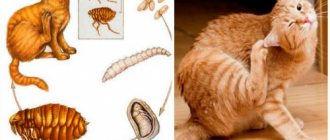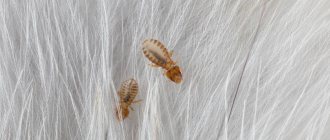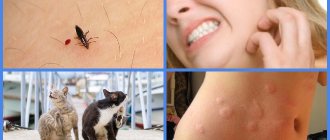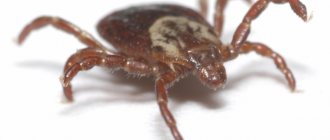Biology of parasites
A pet can become infected from street dogs and cats, as well as basement rats. In order to crawl from the fur of one individual to another, close contact is required. These insects do not have the jumping ability of fleas.
A kitten may also have parasites transmitted from an infected cat.
Nature has not endowed lice eaters with the ability to pierce the skin of the host in order to get enough blood. Therefore, insects are content with animal fur and exfoliated particles of the epidermis. For this purpose, they have a well-developed gnawing apparatus.
Expert opinion
Kalado Irina Sergeevna
Practicing veterinarian, 13 years of experience.
When it’s time to reproduce, the lice eater needs protein - without it, eggs cannot be formed. This is where the animals themselves come to the rescue.
The active movement of parasites across the skin causes itching, and the cat begins to scratch, scratching the skin until it bleeds.
Lice eaters gather at the edge of the wound. Having fed on blood, they crawl to the side (but not far) to lay eggs . For reliability, the offspring is attached to the hairs with a special adhesive substance in which the nits are enveloped.
In 21 days in warm conditions and a week later in winter, the larvae develop into sexually mature individuals. Those, continuing the life cycle, will quickly multiply the colony of parasites.
Does the infection affect the cat's appearance? Yes, because insects feed on animal fur. With severe damage, bald spots may appear on the body.
They also appear from scratching. The sticky mass holds the eggs on the bristles and clumps the fur into tangles that are difficult to comb out.
Harm from parasites to animals
A spoiled appearance is the most harmless of the problems caused by parasites.
Scratches on the body of cats are an excellent gateway for fungal and bacterial infections. Once microorganisms get into the wounds, the itching intensifies many times, forcing the cat to intensively scratch the skin.
As the inflammation site grows, it attracts arthropods.
In search of food, lice eaters travel throughout the animal's body.
They do not disdain the area near the anus. There, insects can “feast” on the eggs of the cucumber tapeworm. Those, once in the intestines of the parasite, turn into procercoids.
If a pet accidentally ingests an infected lice eater, the transformation of the intestinal parasite into a sexually mature individual will occur inside the animal. The cat will become a carrier of cestodes.
Is the lice eater dangerous for humans?
Some claim that these pests are not capable of harming people, such as fleas or ticks. After all, they need animal fur to develop.
But there is a risk for humans. While interacting with a cat, the owner may accidentally swallow a microscopic lice eater. This leads to infection with cucumber tapeworm.
Dipylidia provokes disruption of the digestive system, causing allergic reactions and the development of anemia.
When a person is infected with a tapeworm, the following symptoms are observed:
- stomach ache;
- nausea;
- itching in the anus;
- insomnia.
Children are usually infected with helminths: they are more likely than adults to have close contact with pets.
Treatment of trichodectosis (hairworms) in dogs
Let's figure out how to treat lice in dogs. The owner must remember that if the dog becomes infected with lice eaters, he must immediately contact a veterinarian. Self-medication not only makes no sense, but can also lead to serious consequences, since incorrectly selected medications can only dull the symptoms of the disease for a while. Meanwhile, the neglected condition gradually leads to complete baldness of the dog.
A solution for external use, used for the prevention and control of ixodid ticks, fleas and more
Dogs sick with lice eaters are treated with insecticides 2-3 times with a time interval of 7-10 days. It should be borne in mind that a one-time treatment with insecticides can destroy only adults and larvae, while the eggs themselves remain intact.
- Oxamate
is a natural or synthetic chemical used to kill and repel infective insects in dogs. - Turingin-B
, a biological preparation produced in the form of a grayish-brown powder or liquid solution. - Gomelin
, one percent aqueous suspension. - Aerosol products “Acrodex”
,
“Dermatosol”
,
“Bolfo”
,
“Tsiodrin”
,
“Perol”
.
To protect your dog from various diseases and especially from annoying lice eaters, it is necessary to constantly follow preventive measures. Prevention consists of regularly cleaning the animal’s premises, shaking, washing and cleaning the bedding, wet cleaning in the apartment, and disinfection.
All these actions will reduce the risk of lice-eater infection. During treatment, it is better to protect the dog from contact with family members and other pets.
From time to time, your dog needs to be taken to the veterinarian for an examination. When detected in time, lice eaters and their eggs are easier to destroy and treat. You should not allow it to become neglected when the process of baldness begins.
It is difficult to visually determine an infestation with this type of tick, so it is important to pay attention to changes in your pet’s behavior. What do lice eaters look like in dogs? Externally, the lice eater resembles fine dandruff. Having a light yellow, almost transparent color, they are difficult to identify visually due to the small size of the individuals; they are no more than 2 millimeters in length
Having a light yellow, almost transparent color, they are difficult to identify visually due to the small size of the individuals; they are no more than 2 millimeters in length
What do lice eaters look like in dogs? Externally, the lice eater resembles fine dandruff. Having a light yellow, almost transparent color, they are difficult to identify visually due to the small size of the individuals; they are no more than 2 millimeters in length.
It is impossible to determine when a pet is infected with hair mites, since the animal leads an active lifestyle.
How to determine if your pet is infected with lice eaters
Treatment of lice in dogs comes down to regular treatment of the animal's fur. But it is worth noting that in severe cases, additional treatment with antibiotics is required if the dog develops additional infections due to the hair mite.
The use of a spray, although effective, often provokes the development of allergies or an overdose of the dog. The reason for this is a number of side effects that can further harm the pet’s already weakened body.
The problem with using any insecticide, such as drops on the fur or sprays, is the danger of getting the product into open wounds on the dog's skin. Therefore, this fact complicates the use of drugs that are fast-acting but dangerous for the animal.
It is necessary to treat the inflamed areas of the animal's skin with hydrogen peroxide and brilliant green to protect the pet from other infections and bacteria entering the wound. For severe itching, there is a special product called STOP-itch for dogs. Treatment of lice eaters in dogs can take several months, especially with serious damage, since these pests multiply very quickly.
You can prevent the appearance of lice in dogs through prevention. This is something that owners of pet fluffies often neglect, thereby provoking the development of additional problems. Dealing with lice eaters is simple, the problem is more in the consequences caused to the health of the animal. After all, lice eaters are carriers of other dangerous helminths and infections, some of them are dangerous even to humans, for example, the cucumber tapeworm.
Signs of infection
The main symptom by which the presence of parasites can be determined is severe itching. It is worth mentioning other signs of infection.
- “Feeding” from the cat’s skin wounds, lice eaters leave their saliva there. By becoming sensitized, it provokes an allergic reaction in the animal. A skin rash can be found in these areas. An infection is connected to it, and pustules form on the body.
In places of calculations, the dermis thickens, coarsens, and becomes rough. The skin swells, and pockets of inflammation remain on it for a long time.- By eating cat hairs, the parasite spoils the animal's coat. As a result, large bald spots can be found on many parts of the body.
- A characteristic sign of the presence of a lice eater is bristles gathered into sticky clumps. Cats with long hair are especially affected by this.
The animal on which lice eaters live becomes weaker and its immunity drops. This leads to an invasion of subcutaneous mites. Otodectosis, notoedrosis, and demodicosis develop.
To finally make sure that a cat has lice, you should carefully examine its feces. There will definitely be remains of cucumber tapeworm there.
Entomoses in cats
Entomoses (Entonioses canum et felinae) are single-symptomatic diseases of cats, which are caused by temporarily and permanently parasitizing insects on their body. In other words, these are all the parasites that we talked about above.
Feeding on blood, interstitial fluids, hair and epidermal scales, these invertebrates cause great harm to cats, causing anxiety to the animals. The irritations formed at the site of bites are very painful and cause itching, and their subsequent scratching with paws forms fertile open-skin soil for the development of various infectious inflammatory processes, dermatitis and phlegmon.
For example, picking fleas out of fur with your teeth allows the animal's salivary secretions, rich in bacteria, to reach damaged skin and increases the likelihood of contracting other serious cat diseases.
The insects themselves can become carriers of pathogens of various cat diseases - plague, cucumber tapeworm (fleas), and an intermediate link in the chain of transmission of helminths, bacteria and viruses.
Intensive attacks by parasites, especially fleas, lead to the development of exhaustion of the cat's body and a lag in the growth and development of young individuals. The reason for this was the selection for parasitism of those areas of the body surface that are inaccessible to the animal in order to get rid of the pest on its own - the folds of the body, behind the ears, near the nose and below the chin.
Of the millions of species of insects that exist in nature, domestic cats are mainly susceptible to parasitism by lice, fleas and lice-eaters. Diseases of cats that are caused by these insects are collectively called entomoses. What these three parasites have in common is a three-part body structure (head, thorax and abdomen) and division into sexes. Development can be complete (egg, larva, pupa, adult) or incomplete (the third stage is omitted).
A permanent ectoparasite of cats with a complete transformation path is the lice beetle. These small wingless parasites are common to cats and dogs (Trichodectes canis and Felioola subrostratue). They feed on hairs and scales of the epidermis, causing the animal to become bald and emaciated.
One of the entomotic diseases of cats common to humans is diseases caused by lice. Another wingless parasite that also feeds by blood-sucking through skin punctures is fleas. Cats are affected not only by the cat flea (Ctenocephalides felis), but also by the dog flea (C. canis) and the human flea (Pulex irritans). This is a temporary and most common ectoparasite that requires immediate treatment for your cat.
With the development of such enthymous diseases of cats, the symptoms are usually common and require the same diagnosis. Treatment of cats for different parasites is also similar.
How is diagnostics carried out?
At home, you can visually examine your pet. The parasites are so small that they are difficult to notice right away. They practically do not appear on the surface of the fur coat - they stay closer to the skin.
The inspection should begin with tangles. If the fur in these places is still sticky, a clutch of pale yellow eggs or larvae hatching from them will be found inside the lump.
Adults should be searched for using this method:
- bring the cat as close as possible to the switched on table lamp;
- spread the fur in the illuminated area;
- wait a few seconds.
Lice eaters react to heat and choose those areas where the temperature is higher. Therefore, they will very quickly move from the roots of the hairs to the edge to warm themselves.
You can take a magnifying glass and see the miniature, flat, wingless insects that cause discomfort to your pet.
To accurately identify parasites, you need to know where to look for them. The favorite places of lice eaters are the head (especially the ears), paws on the inside, and the tail area.
Fleas on cats
Fleas are wingless insects of the Ctenocephalus species that parasitize the cat's body. In addition to feline C.fells, the body can be affected by canine and human parasites.
The body of all adult Ctenocephalus is small, wingless, pale or brown in color, and strongly laterally compressed. It is placed on long strong limbs, abundantly strewn with spines, which allows the parasite to quickly move from individual to individual and attach to the fur. The mouth is adapted for piercing and sucking blood.
Cats become infected through direct contact with infested individuals or through their care items, but are more often found in stray cats that live in unsatisfactory conditions.
Treatment
A cat cannot get rid of parasites on its own - fleas hide in the folds of the body, near the nose and below the chin, where she cannot reach them. Therefore, if fleas are found on the body of an animal, the owner must take upon himself the treatment of cats. It is easy to distinguish this ectoparasite from the no less common lice eater by its appearance - the latter has a head wider than its chest. The method of treating cats will not be different - first you need to destroy parasites on the body with the help of careful application of insecticides (chlorophos, synthetic pyrethroids in combination, microbial preparations Turingin-B and Gomelin, aversectin ointment, zoological shampoos, mildly toxic oxamate for kittens, systemically acting drugs emulsions or aerosols - dermatosol, cyodrine).
After two weeks (the period of hatching of the larvae), re-treat or use a drug with a long-term residual effect for the first time, disinfest the habitat and care items with boiling water, and avoid contact with sick animals to prevent the possibility of re-infection; keep the animal itself clean, periodically clean the sleeping area and change the bedding, disinfest the entire house and wear a collar impregnated with insecticides for prevention.
Methods of struggle: general provisions
Lice eaters are similar to other insects that parasitize cats. Therefore, they should be combated with long-term insecticidal preparations. Treatment should be selected by a veterinarian.
Recommendations for owners:
- any of the drugs does not act on nits, so the frequency of treatment is important: 2-3 procedures will be needed with an interval of 2-15 days (depending on the chosen product);
- products are selected carefully, individually in each specific case, many of them are not suitable for treating kittens, lactating and pregnant females;
after treatment, safety measures are taken: a special collar is put on the animal and removed after half an hour - this will not allow the cat to lick the applied product from the fur;- for the same reason, the pet is temporarily isolated from children and other animals.
Any product containing insectoacaricidal compounds can be included in the treatment of a cat. These include shampoos, sprays, drops, anti-flea collars.
How to prepare an animal for processing
Before using the drug against parasites, the cat is prepared for the procedure.
If the instructions do not provide recommendations on this matter, then the following rule is followed: the pet is not bathed for 3 days before treatment and the same amount after it.
How to treat lice in dogs?
If there is a suspicion that an animal is infected with a parasite, the owner should contact a veterinarian. The doctor will conduct an examination, study using an electric lamp, which allows identifying insects at all stages of development, and take scrapings from the skin. Based on the results of the study, the specialist will prescribe treatment with insecticidal drugs. The course of therapy is usually 5-6 weeks. To quickly get rid of pests, it is recommended to change the bedding on which the dog sleeps, treat upholstered furniture in the house, and also, for preventive purposes, treat the hair of other animals, if you have them.
To improve the pet’s general condition, he may be prescribed oral vitamin tablets and special food. You need to take them until complete recovery.
Sprays
These are the most convenient drugs to use. They are used like this:
- Apply sprays to the dog's entire body (avoiding the mucous membranes of the nose, mouth, eyes).
- Wait for the time specified in the instructions.
- They comb out dead insects from the fur and then bathe the pet.
The most effective sprays are “Defendog” and “Frontline”
The preparations allow you to get rid of pests in two treatments, but require careful use. The dog owner needs to ensure that the animal does not lick the product from its fur and skin, otherwise it may be poisoned by it.
Shampoos
These products are suitable for pets of any age, including weakened puppies. They allow you not only to get rid of parasites, but also to remove itching, and also improve the condition of the hair. The following shampoos against ticks are considered the most effective:
- "Leopard".
- "Demox-Lux".
- “Phytoelite”.
Using the presented tools is not difficult. It is enough to buy your pets this shampoo, then comb their fur to remove dead insects. Since such drugs have a short-term effect, treatment with them should be carried out weekly until the parasites are completely eliminated. If you miss at least one session, ticks may breed again.
Drops
Such products are considered the most effective, as they have a long-lasting effect and provide protection for the animal from pests for eight weeks. The most effective of this group of drugs are considered to be “Frontline”, “Prak-tik”, “Bars”, “Ibris”. The medicine is used as follows:
- The animal is bathed with anti-flea and tick shampoo.
- The wool is thoroughly combed, dead insects and their eggs are removed.
- Apply a few drops against pests to the animal’s withers.
This method will be most effective in the early stages of the disease. If you apply it in the first week after infection, you can get rid of all parasites in one session and then carry out only preventive treatment.
Aerosols from lice eaters
Sprays are considered the most convenient and effective remedies for parasites.
Expert opinion
Burmistrova Alena Valerievna
Breeder, 7 years experience.
The drug should be used strictly according to the instructions. It indicates how many times you need to press the head of the can, taking into account the body weight of the animal, whether there are restrictions on the physiological characteristics and age of the animal.
If there is no mark that the product is approved for lactating, pregnant cats and small kittens, then it is better not to use it.
The drug is sprayed all over the body, being careful not to get into the pet’s eyes. Where it is inconvenient to apply an aerosol from a can, do it manually, rubbing the product in with your finger.
Careful treatment will provide protection from ectoparasites for approximately 1-1.5 months. Then it is advisable to repeat the processing.
When choosing a spray insecticide, you should pay attention to the following brands: Bars, Bolfo, Hartz, Fiprist, Frontline.
Lice in cats
Lice are one of the most contagious entomotic diseases of cats. The body is parasitized by insects (up to 3 mm in length) that do not have wings and move with the help of a highly developed third pair of limbs with claws for attaching to the skin of the animal. The flattened body is much wider in the chest area than the head. Lice feed exclusively on blood, absorbing up to 10 mg at a time.
When this cat disease appears, the symptoms disappear immediately in the form of itchy skin sensations and a corresponding irritable reaction. The movement of insects, the moment of piercing and the subsequent 5-10 minutes of blood sucking make the cat anxious and want to comb out the lice. Scratches from claws often appear at the sites of bites, and roughness and peeling form on the skin. Animals quickly become exhausted and lose weight.
Animals that are not cared for, as well as those that come into contact with infected individuals, are most susceptible to this disease of cats. The number of parasites on the body increases with the onset of cold weather, when the coat becomes thicker.
Diagnosis of entomosis can be made simply by the characteristic symptoms of the disease in cats. Adult lice and nits attached to the fur are identified on the body.
To treat cats with entomosis, adult cats are destroyed by using insecticides: bathing in an aqueous solution of chlorophos in the warm months of the year, thoroughly treating the skin with an emulsion of soap K or a suspension of Sevin.
- If it is already cold and the coat has become thicker, it is necessary to treat it with a dust or aerosol (for example, insectol).
- There are also products in the form of shampoos and powders, which can now be purchased at any veterinary pharmacy.
- After 12-18 days, the procedure must be repeated in order to destroy the new individuals that hatched during this time.
You need to carefully monitor your cat and prevent it from licking its fur, because many drugs are particularly toxic and can lead to poisoning. Therefore, it is best to treat small kittens with less toxic products or simply comb them.
To prevent the appearance of parasites and subsequent treatment of cats, it is necessary to constantly examine the pet’s body and maintain the cleanliness of the skin, disinfect the habitat and care items, and treat the litter with boiling water. For this feline disease, treatment is proven and effective, but it is better to take full advantage of preventive measures and prevent symptoms of the feline disease from appearing.
Drops Spot-on
The product is sold packaged in disposable pipettes.
The drug is universal, it allows you to protect your pet not only from lice eaters, but also from other ectoparasites, as well as helminths, cucumber tapeworm, heartworms.
The following drugs are most in demand:
Advocate;- Helmintal;
- IN-AP complex;
- Inspector;
- Stronghold.
The principle of using the product is implied in the name of the type of drops. Spot means “straight to the point.” The product is applied to the most inaccessible place for the cat - the withers, choosing an undamaged area of the skin.
Shampoos for parasites
Eco-friendly insecticidal detergents are made from natural raw materials.
Repellents are extracted from the sap of plants that can repel parasites. Therefore, shampoos are non-toxic and are considered safe for kittens.
But they do not protect against re-infection. Such drugs will have to be used frequently or used as an addition to other drugs.
Among the eco-shampoos for cats, the most popular are Beafar, Lugovoy, Dana, Rolf-Club, and Four with a Tail.
Information about treatment and prevention
Treatment is quite simple. Today, the veterinary pharmaceutical industry produces hundreds and thousands of products that effectively destroy ectoparasites. Many drugs contain pyrethrins or organophosphates.
The veterinary experience of specialists from different countries shows that drugs based on Imidacloprid and Selamectin have proven themselves to be the best. Permethrins (not to be confused with pyrethrins) are very effective insecticides, but preparations based on them should under no circumstances be used to treat cats! They are exclusively for dogs! These substances cause severe poisoning in cats, and therefore it is not worth treating dogs with them if they can come into contact with cats.
There are quite harmless and effective folk remedies. Wormwood decoction and wormwood oil have proven themselves to be the best. It is applied in small quantities in different places in the room where the animals are kept. Fresh and dried wormwood branches are very good if you put them in a basket for kittens/puppies. The likelihood of fleas and lice appearing in this case is reduced significantly.
Do not wash your pet with insecticidal shampoos more than once a week for 4-6 weeks. If the product is good, this frequency of treatment is quite enough. The exposure time (that is, during this period you need to keep the shampoo on the coat) is about five to six minutes. In any case, all this information should be included in the instructions for the drug. Do not rush to rinse the shampoo off your pet's skin too quickly, as this will likely greatly reduce its effectiveness. Only patience and accuracy will help you defeat entomosis in dogs and cats!
Collars
The accessory is called an anti-flea accessory, but in fact the collar protects against all ectoparasites.
The product with which the strap is impregnated provides a long-lasting effect, but is toxic. Therefore, it is contraindicated for babies, pregnant and lactating cats.
When choosing among the brands offered, it is recommended to pay attention to the collars Bars, Beafar, Bolfo, Celandine.
Prevention of lice eaters
Knowing where these parasites come from in animals makes it easier to fight them. In prevention, the main rule is to keep the enemy out.
Therefore, the owner should pay maximum attention to caring for the cat:
monitor the animal’s nutrition;- observe hygiene standards;
- keep the room clean.
Don't wait for lice eaters to appear. It is better to use parasite repellents in advance as a preventative measure.
The rug on which your pet likes to bask should also be treated periodically..
What is the danger?
The vital activity of parasites can force the animal to refuse food.
Unnoticed signs of lice in cats in time can lead to serious problems that will be more difficult to deal with. The following complications arise against the background of a parasitic disease:
- Helminthiasis. In pathological conditions, lice eaters actively transmit eggs of endoparasites, including tapeworms.
- Diseases of infectious origin.
- Allergic reaction. This phenomenon leads to severe rashes, swelling and hair loss in the cat.
- Problems with appetite. In advanced cases, due to the activity of lice eaters, the pet completely refuses to eat and the body becomes exhausted and the immune system weakens.
- Exacerbation of chronic diseases.











